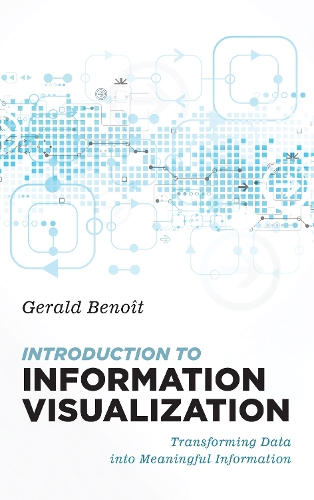
Introduction to Information Visualization: Transforming Data into Meaningful Information
(Paperback)
Publishing Details
Introduction to Information Visualization: Transforming Data into Meaningful Information
By (Author) Gerald Benoit
Bloomsbury Publishing PLC
Rowman & Littlefield Publishers
8th February 2019
United States
Classifications
Tertiary Education
Non Fiction
Information visualization
001.4226
Physical Properties
Paperback
224
Width 147mm, Height 228mm, Spine 15mm
367g
Description
Introduction to Information Visualization: Transforming Data into Meaningful Information is for anyone interested in the art and science of communicating data to others. It shows readers how to transform data into something meaningful - information.
Applying information visualization in research, service, teaching, and professional life requires a solid understanding of graphic design and the aesthetic along with hands-on skills and knowledge of data principles and software. This book is applicable to students in all domains, to researchers who need to understand how to create graphics that explain their data, and to professionals and administrators for professional development training. Website Designers and Human-Computer Interaction researchers will appreciate the backstory of designing interactive visualizations for the web.
Drawing on the authors years of practice and teaching, it bridges the two worlds in ways everyone can participate in the future of information and to appreciate the beautiful in information:
Step-by-step directions in the fundamentals of HTML5, CSS, and d3.jsDesign challenges with fully explained answersWeb-site support for code samples (JavaScript, d3.js, python), live examples, and a place to build a community of other IV prosUseful for teaching design to scientists; data to the humanitiesGuidance for using the text depending on the class makeupReview of third-party visualization software, big data trends, and script librariesGuidance on how to continue in the IV world after graduation
This full-color book features graphics and a companion Web site.
The online companion site hosts living examples, updates, and errata. Youre invited to participate on the site, too, sharing your questions, solutions, and ideas. For most readings, there is a partner design lab. At the conclusion of the course, there is a complete interactive information visualization service documentation for libraries.
Reviews
A picture is worth a thousand words. Or perhaps more precisely: a well-constructed graphical representation is worth a thousand words. A poorly constructed visualization, however, can be a disaster. Benot (computer science, UC Berkeley) has written a well-organized, informative monograph of just over 200 pages on visualizing information. Benot begins with explanations and illustrations of the terminology used in the book before moving on to present the book's philosophy in a chapter intriguingly titled "The Ethics/Aesthetics of Information." The subsequent chapters lead us from the concepts of visualization to the organization of data and the application of web-based tools that are available to assist in visualization construction. Benot then elaborates on the richness of the web-based visualization tools and reflects on the roles these tools play in presenting effective visualizations; several examples are discussed. A companion website provides design labs to facilitate hands-on practice, as well as updated examples. Each chapter has its own set of references, and the monograph has a thorough index. * Choice Reviews *
As a textbook for an introductory course on information visualization, the book provides an insightful perspective on information visualizationits communicative nature, which naturally draws our attention to factors that we should bear in mind when we approach the design of information visualization. The emphasis on hands-on experience is practical for students who wish to incorporate various design principles in their own projects. In short, I would highly recommend this easy-to-read, engaging, and thought-provoking book either as your first introduction to information visualization or as a refresher with an intriguing perspective. * Journal Of Education For Library and Information Science *
Benot's book is breath of fresh air, providing an equal platform between fine art and science, closing a gap not found in other information visualization textbooks. Benots expertise in the field brings out the aesthetic and artistic side of InfoViz without compromising the science side of data. The beauty lies in the real-life examples and on-hands, experiential approach to the field. -- Anastasia S. Varnalis-Weigle, Assistant Professor, Information and Library Science, University of Maine at Augusta
Benot successfully covers a range of intersecting topics in information visualization, from the technical to the aesthetic. He brings clarity to this complex space using a number of well-selected examples, and his interdisciplinary approach makes it accessible to a range of students and professionals. -- James E. Andrews, Director, School of Information, University of South Florida
This book is an original voice from an expert in information visualization. By building on easy-to-learn skills, it combines basics of web development with knowledge of information visualization and gives simple tips to improve visual aesthetics through the design. Practical tools introduced in the book allow a hands-on experience. I highly recommend this book as a DIY for any one interested in the field. -- Banafsheh Asadi, School of Information Studies, McGill University
Author Bio
Gerald Benot, Ph.D., teaches across a range of interrelated topics - information science, computer science, programming, web design, systems analysis, visual communication, and information visualization. He teaches data science courses for UC Berkeleys Data Science program. Before joining UC Berkeley, Prof. Benot was a faculty member at Simmons College for fifteen years, teaching in the information science and computer science programs. There he taught at undergraduate, graduate, and doctoral levels.
Prof. Benots background includes training in graphic arts and production, at one time art director and partner in the advertising firm Imada, Wong, Park, + Benot (continues as IW Group), and as an information scientist writing on human-computer interaction, information visualization and aesthetics, communications theory, and language models in search engine design.
Prof. Benot has been an invited lecturer at Harvard University, the University of Rhode Island, Simmons College, and elsewhere to lecture on the opportunities of visualization in business, as a service, and professional education.
